Asbel/Evans
Library hosts free jazz, blues concert Page

Got
Dance team wins eighth straight title


Asbel/Evans
Library hosts free jazz, blues concert Page

Got
Dance team wins eighth straight title

March is already here, believe it or not, which means Town Meeting Day is right around the corner.
From competitive council races to a charter change expanding the school board, a $65 million city budget, and a new water tower South Burlington residents will cast deciding votes on several items on the city ballot.
City council election
South Burlington’s city council race is wide open, with six candidates vying for three open seats.
Planning commissioner Laurie Smith and former 2022 council candidate Linda Bailey will vie for the three-year term vacated by council chair Helen Riehle, while Mike Scanlan, a former U.S. diplomat, will face city conserva-
tion member Julian Keenan and Lydia Diamond for council vice chair Meaghan Emery’s two-year seat.
Elizabeth Fitzgerald, meanwhile, is running unopposed for a two-year seat vacated by Tyler Barnes in October. Barring a write-in campaign, she will likely take over the remaining year of that term.
Whoever wins will join councilors Andrew Chalnick and Tim Barritt on the council of five.
The Other Paper interviewed each of the six candidates running for council. Those interviews can be found here bit.ly/49MUEQ0.
Residents will vote on a nearly $65 million budget that comes with a 5.82 percent municipal tax rate increase.
See TOWN MEETING DAY on page 17

The South Burlington Cheerleading team took first place at the Northern Vermont Athletic Conference as Metro Division Champions for the second year in a row and scored the highest in history of the school’s cheerleading program. The team also competed in four competitions, placing 2nd in the Central Vermont Competition, second in the Vermont Cheerleading Coaches Association Invitational and second in the Division I State Championship. South Burlington also qualified to compete in the New England Cheerleading Competition in March. The team in front, from left,
With less than a week to go before South Burlington’s City Council elections, the entrance
of a political action committee into the fray has stirred criticism and has renewed conversations around campaign finance in the city.
Running for city council has

become an increasingly expensive endeavor in South Burlington, with campaign contributions and spending topping out over $15,000 in some cases. This year is no different.
Six candidates are vying for the council’s three open seats. Council Chair Helen Riehle and vice chair Meghan Emery announced that they would be stepping down, while Councilor

Larry Kupferman, who replaced former councilor Tyler Barnes, is not seeking reelection.
See COUNCIL RACE on page 19
I am proud to endorse Linda Bailey for South Burlington City Council. Linda is a dedicated community servant and volunteer who understands the affordability crisis facing our community. She will keep a close eye on the budget, focus on essential services, and not burden taxpayers with costly new programs that we can’t afford.
— Matt Cota, former South Burlington City CouncilorLinda Has put in the time and effort to learn about the needs of South Burlington and all of its citizens. I support Linda Bailey for City Council.
— Tom Chittenden, State Senator
I support Linda Bailey for City Council. Linda will serve without a predetermined agenda but rather will engage with the entire community to determine our needs. Her balanced approach towards the environment, tax burden, cost of living, and coordination with the needs of our schools comes at a critical point for South Burlington.
— Michael KellerI am impressed with Linda Bailey’s energy and commitment to serving our entire South Burlington Community!
— Michael SimoneauLinda’s life experience, proven human relationship skills and knowledge of City affairs will be a tremendous asset on the council.
 — Sandy Dooley
— Sandy Dooley
Linda Bailey’s vision for attracting investment and fostering innovation is exactly what our city needs to thrive economically and environmentally.
— John Burton
The South Burlington City Council passed an ordinance establishing a rental registry and added regulations onto the growing number of short-term rentals in the city.
Beginning April 1, all rental units in South Burlington will be required to register with the city, pay an annual fee and make those units available to city staff for inspection to ensure compliance with the city’s various fire and building codes.
Meanwhile, short-term rentals, operated through companies like VRBO and Airbnb, will now only be permitted in owner-occupied units — or housing where the owner resides for at least six months and one day — and accessory dwelling units.
Existing short-term rentals that don’t meet those requirements have four years to operate before the regulations take full effect in April 2028.
Annual fees would be used to self-fund an office and dedicated staff in the city’s fire department for inspections. The fire
department is typically responsible for conducting inspections but have only done so when they receive complaints. They’ve received 55 complaints over the last two years.
Owners of long-term rentals would pay $150 annually — fees for new construction of greater than 10 units are waived for three years, while long-term rentals meeting the city’s affordability requirements will pay a reduced fee of $25.
Short-term rentals that are owner-occupied would pay $150 as well, but existing short-term rentals in the four-year exemption period would pay $1,500 annually for inspections.
South Burlington now joins Burlington, Winooski and St. Albans in creating a rental registry. Essex Junction is also currently in the process of passing a rental registry into law, according to reporting from the Essex Reporter. (Read about Stowe’s foray into short-term rental regulation at bit.ly/3TeArx9.)
While some of the fees are higher than
See RENTAL REGISTRY on page 20
Although the passage of a new bill last week made major changes to the state’s education funding formula, the South Burlington School Board decided not to retool its $71 million budget and stay the course with a vote on Town Meeting Day, but the decision was not unanimous among board members.
In an eleventh-hour change by the Legislature this month, the new law, H.850, passed just weeks before Town Meeting Day alters the already complicated education funding formula known as Act 127 that has caused headaches for school officials crafting budgets this year.
In addition to removing the originally proposed 5-percent tax increase cap meant to soften the blow for districts negatively affected by the new funding formula, the new bill also allows districts the option to delay their school budget votes until April 15 to provide time to revise spending plans.
With the $71 million budget under Act 127, South Burlington property owners would have seen an 18 percent tax increase, but under stipulations of the new law that replaces that 5 percent cap with a new calculated percentage discount, South Burlington residents are faced with a 23 percent tax increase associated with the approved budget.
“H.850 revises the calculation that
school districts used to determine budgets, so everything that we’ve been working on since September when we began evaluating student data, this is really changing how we would look at this,” superintendent Violet Nichols said.
In an already stress-inducing budget season, school boards are now grappling with even tougher decisions like whether to completely redraft budgets in time for a vote on April 15, or face the realities of unprecedented double-digit tax increases associated with budgets that were passed earlier this year under a different education funding model.
Residents aren’t the only ones who are confused and concerned.
“By March 30, reduction in force (RIF) notifications would be sent from my office to staff,” Nichols said. “Should the budget not pass, and the board wouldn’t have a new budget ready to move forward, the district would have to RIF incredibly deeply to account for this worst-case scenario number.
So, some of the operational concerns there are staff morale, which is a huge factor. The mental and physical well-being of staff is something that absolutely impacts students. There’s also the possibility that we could lose really great staff who are going to work in other districts.”
Under provisions within Act 127, the

Here are some specific initiatives I want to accomplish:
• Conserve open lands that contain natural resources
• Continue to incentivize and build affordable housing
• Prevent sprawl along with its accompanying tax increases
• Create a village green in city center and identify other areas across the city for recreation and open space
• Build safe bike and pedestrian paths
• Strengthen and enforce our noise ordinance
• Phase out gas leaf blowers

Dear Residents of South Burlington, Local elections actually matter, and that is why I am stepping up to promote a positive vision in my campaign for the South Burlington City Council. I am not doing this for my resume, career, or any reason other than wanting this place to remain a vibrant, compassionate, outdoor-oriented community with excellent schools and successful businesses where children of all backgrounds can thrive.
My wife and I chose to make South Burlington our home because we were captivated by the warmth of this special community. But, as a young father raising my family here, I am concerned that the exponential growth and consumption mindset is working its way into our town's politics and putting some of our important strengths at risk. Let’s grow and maintain our natural beauty at the same time.
In this age of uncertainty and division, we should reject some of the aspects of American society that do not improve our quality of life or the health of our community and instead focus on making South Burlington a beacon of resilience and well-being. While we may feel powerless to control larger global trends, we have the power to make our community exceptional in facing future challenges. South Burlington has the potential to be an oasis amidst the chaos of the world. Let’s make a commitment to not give up on that.
If elected to the City Council, I want to partner closely with the School Board to address their challenges and make sure that we maintain the high quality of our schools. I want to work closely with local businesses, especially small businesses, to ensure we are facilitating the right environment for them to prosper. I want our first responders have the resources they need to keep our community safe. And finally, I want to protect our natural resources from exploitation.
Please watch my recent City Council debate and decide for yourself if I would be a good advocate for you and your family. You can search Google with "South Burlington 2/16/2024 debate" or use the QR Code below to access the YouTube video.
Let's allow substance and vision to rule the day. Thank you for taking the time to read this.



Gov. Phil Scott on Feb. 22 signed into law H.850, a bill that repeals a controversial property tax cap and allows school boards to push back budget votes to lower education spending and, in turn, property taxes.
“The changes made in this bill are a necessary step as Vermonters face a projected 20 percent increase in property tax bills, and in some communities, it could be even higher,” Scott wrote in a letter to lawmakers. “But to be clear, this bill does not solve our property tax problem. These changes will only reduce rates if school boards adjust their budgets accordingly and local voters support those changes.”
The Senate expedited passage of the bill, which it sent to the governor on Feb. 21.
Lawmakers called the “time-sensitive” bill, H.850, a “Band-Aid” in addressing property taxes. But in a spirited floor session last week, many acknowledged the changes wouldn’t be enough.
Senate President Pro Tempore Phil Baruth, D/P-Chittenden Central, said the Legislature would need to come up with “groundbreaking” new ways to contain public education costs this year.
H.850 would repeal the 5 percent homestead tax rate increase cap created by Act 127 — Vermont’s most recent education funding law — and replace it with a tax discount system limited to districts that lost taxing capacity under the new pupil weighting system created by the law. The bill also would allow school districts to alter their budgets as lawmakers hope removing the property tax cap would spur school boards to remove spending, thus lowering property taxes.
School district leaders say the spending increases are needed to maintain the status quo due to inflation, rising staff health care costs and teacher salaries and the increased needs of Vermont’s children, an increasing number of whom are struggling with mental health challenges.
Compared to other U.S. states,
South Burlington’s Community Newspaper Since 1977 A publication of Vermont Community Newspaper Group LLC otherpapersbvt.com
Advertising Director
Judy Kearns judy@otherpapersbvt.com (802) 864-6670 x21
Advertising
Wendy Ewing wendy@shelburnenews.com (802) 985-3091 x12
News Editor
Tommy Gardner
Staff Writers
Aaron Calvin Corey McDonald
Liberty Darr
Production Manager
Stephanie Manning stephanie@shelburnenews.com
Editor/Publisher Gregory Popa gpopa@stowereporter.com
Billing inquiries
Leslie Lafountain leslie@stowereporter.com (802) 253-2101
Advertising submission deadline: Thursday at 5 p.m. advertising@otherpapersbvt.com classifieds@otherpapersbvt.com
Editorial submission deadline: Friday at 5 p.m. news@otherpapersbvt.com
Calendar submission deadline: Friday at 12 p.m. news@otherpapersbvt.com
Contact: 1340 Williston Road South Burlington, VT 05403 (802) 864-6670
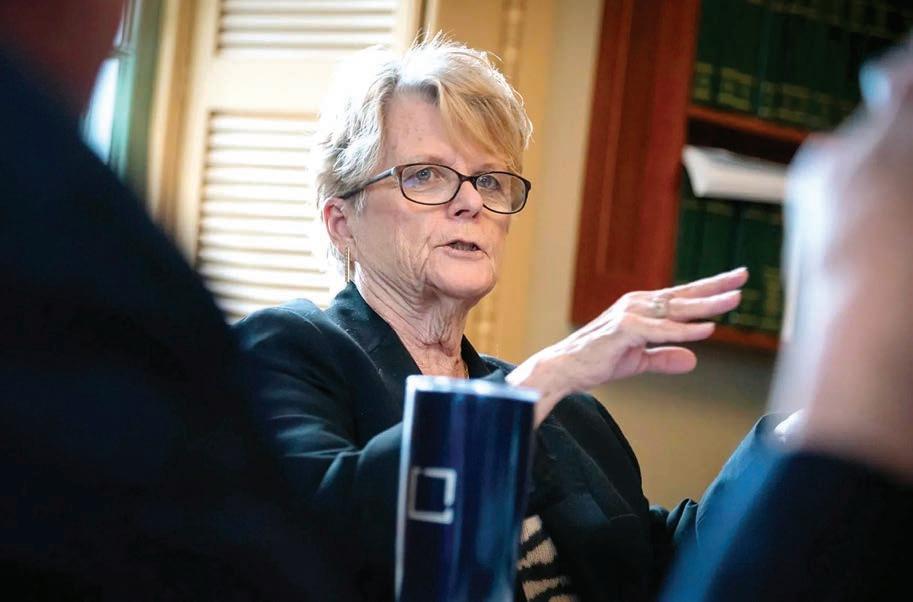
Vermont ranks at or near the top in terms of public education spending per student and studentto-staff ratios.
Earlier this year, legislators grew concerned that Act 127’s tax increase cap was encouraging districts to add extra money to their budgets, calling it an “unintended consequence.”
Scott’s finger-pointing at lawmakers has become a repeated refrain as Vermonters face a projected average property tax increase of 20 percent, driven by
a predicted 15 percent increase in education spending.
The law will also allow school districts to push back budget votes until April 15, as lawmakers hope removing the property tax cap will spur school boards to remove spending. Many districts had planned to put budgets in front of voters on Vermont’s Town Meeting Day, which this year is March 5.
It remains to be seen how much money districts might take out of their proposed budgets with
H.850’s prompting. Lawmakers in both chambers have also signaled they will consider increasing revenue sources to the education fund, which would also reduce property taxes.
Future cost containment measures were actively discussed on Tuesday in the Senate Committee on Finance, as Sen. Ann Cummings, D-Washington, and Sen. Thomas Chittenden,
See H.850 on page 19
Total reported incidents: 219
Foot patrols: 23
Directed patrols: 16
Public assists: 6
Field contact: 5
Animal problem: 6
Noise ordinance violation: 2
Needle pickups: 1
Agency assists: 6
Traffic stop: 11
Motor vehicle complaint: 8
DUI: 2
Larceny from a vehicle: 5
Suspicious events: 8
Missing persons: 1
Juvenile problems: 4
Disturbances: 11
Domestic incidents: 3
Mental health issue: 3
Welfare check: 5
Property damage: 13
Trespass notice: 10
Larceny: 4
Unlawful mischief: 1
Retail theft: 7
Embezzlement: 1
Fraud: 2
Threats: 6
Alarm: 13
911 hang up: 4
Deaths:
Feb. 20 at 9:16 a.m., William Moore, 69, of South Burlington, was found dead on Aspen Drive. A medical examiner is determining the cause and manner of death.
Feb. 20 at 3:24 p.m., Russell White, 59, of Waddington, N.Y., was found dead on Williston Road. A medical examiner is determining the cause and manner of death.
Arrests:
Feb.21 at 1:06 p.m., Brent Lee LaBombard, 51, of South Burlington, was arrested on Farrell Street on an in-state warrant.
Feb. 22 at 5:43 a.m., Olivia A. Hines, 30, of South Burlington, was arrested on Williston Road and charged with violating conditions of release. She was again charged with violating conditions of release the following day, at 7:07 a.m. on Williston Road.
Feb. 24 at 2:56 a.m., Zachary T. Putnam, 23, of St. Albans, was arrested on I-89 Northbound
and charged with driving under the influence, first offense.
Feb. 24 at 1:52 p.m., Olivia A. Hines, 30, of South Burlington, was arrested on Williston Road and charged with violating conditions of release. Police arrested her again on the same charge at 8:54 p.m.
Feb. 25 at 9:04 p.m., a 13-year-old juvenile was arrested on Dorset Street and charged with disorderly conduct by phone or electronic communication.
Previous incidents:
Feb. 15 at 2:12 p.m., Brent Lee LaBombard, 51, of South Burlington, was arrested on Shelburne Road and charged with misdemeanor retail theft.
Feb. 16 at 6:10 a.m., Olivia A. Hines, 30, of South Burlington, was arrested on Williston and charged with violating conditions of release.
Note: Charges filed by police are subject to review by the Chittenden County State’s Attorney Office and can be amended or dropped.
In 2022 Vermont passed Act 127, with the laudable intent of continuing the state’s commitment to providing a quality education to Vermont kids regardless of zip code. Based upon the impact to school spending and tax rates, the results have been a budgetary disaster.
Education taxes for most Champlain Valley School District communities, where I live, will be up as much as 26 percent, for a proposed budget that is up over 10 percent. A similar story is playing out statewide.
I consider myself an advocate for public education, having volunteered for years at our local parent-teacher association, and served on the school board. I have two kids who spent their K-12 years at Champlain Valley district schools and were very well served there. But I am also passionate about ensuring that
Vermont is an affordable place to live for my kids when they hopefully return to Vermont, and with a relatively high cost of living, and among the highest overall tax burdens nationally, there is a finite ability for us to raise additional revenues.
At this point, dollars we spend on education are ones we can’t invest in affordable housing, expanded drug treatment, bike and pedestrian infrastructure, climate mitigation or any of a host of other critical priorities. While there is never an absolute either-or tradeoff in public investments, the budget balancing math is ultimately fixed.
The question is what the right amount of school spending is. Based upon U.S. Department of Education data for the 2020-2021 school year, we’re second only to New York among states in per-pupil spending, are roughly 22 percent higher than New Hampshire and Maine, and 50 percent higher than the national average. I am happy to see us

investing in our kids, but at this point we are clearly not underinvesting relative to other states.
Are Vermont students achieving significantly higher results for that investment? Unfortunately, according to the U.S. Department of Education’s National Assessment of Educational Progress, our fourth-grade reading, and math scores are now statistically identical to the national average, though we happily fare better at the eighth-grade level.
What’s wrong with Act 127?
First, the Legislature, in effect, created a strong incentive for local school boards to increase budgets statewide by 10 percent, by ensuring that whether a district increased spending by between 5 percent and 10 percent there would be no penalty for overspending. School boards responded to that incentive and warned their budgets accordingly.
The Senate has now approved H.850, which backs out that
incentive, but with the months of planning that have gone into budgets on the part of local boards, many districts, Champlain Valley School District included, are proceeding with their initial budgets.
Second, the updated equalized pupil formula in Act 127 used to determine appropriate spending levels does not take statewide cost of living differences into account, simply assuming instead that it costs more to educate students in rural areas, in small schools, and in districts with a relatively high proportion of English language learners or high poverty rates.
The problem is that in Chittenden County, where a high percentage of Vermont students live, the median house costs two to three times more than in rural parts of the state. Housing costs in turn drive up the cost of everything from child care to the cost of a Friday night pizza and that means we need to pay staff more than in other parts of the state
for the same standard of living. Unfortunately, it is primarily those higher-cost districts that are penalized the most by Act 127.
We need to correct the equalized student formula. If equalized students are going to remain as a driver in Vermont education funding, it needs to accurately reflect the cost of living within a district. The 17 percent cut in student weightings that Act 127 brought to our district will directly hurt our students, and in no way reflects the cost of educating our students relative to lower cost areas of the state.
• School consolidation: While earlier education reform efforts consolidated school districts at the administrative level, much more work needs to be done to drive further administrative efficiencies, and yes, school consoli-
See WORMSER on page 15
Sustainability Strive to meet City’s climate action targets and focus on environmental conservation.
Education Collaborate with School Board to foster exceptional education.
Transportation Develop safe, varied transportation to reduce car travel and increase Bike/Ped and child safety.
Public Safety Continue strong support for our Public Safety services.
Recreation Provide recreational opportunities in all neighborhoods.
“I support the candidacy of Laurie Smith for City Council. He is thoughtful, seeks understanding and consensus through dialogue, and brings a wealth of experience working with local and state policy as a longtime professional in construction. I believe that today ’s and future generations of residents will benefit from his leadership.” Meaghan Emery, City Council Vice Chair
“In my 12 years I have seen a lot of different personalities, talents, a variety of understanding of the issues and approaches to tackling city governance. But rarely does an individual come forward who brings as much to the table as Laurie Smith.” Helen Riehle, City Council Chair I
Darrilyn Peters Doug Goodman McKenzie McClellanMarga Sproul
Mike Turner Jeanne ZagurskyKeith Epstein Noah Hyman
Patty WilliamsMonica Farrington John Bossange Alan Luzzatto
Diane Muhr Francis MacDonald Beth ZigmundDonna Hale
Christina GriffinLaura WatersHayley Shen Ray Gonda
Karen Ryder Glenn Sproul Scott Cohen Eleanor Slattery
Wayne Senville Scott Gardner Anne Vera Susan Saferstein
Shana Mleko Gary Keller Joni AvRutick Andrew Chalnick
Susan Schoenfeld Steve Comeau Jennie Lowell Lynne Poteau
Carol McQuillen Donna LebanFrank Kochman Tim Barritt
Marcelyn MurraySam Swanson Jed Lowy Michael Mittag
Steve Crowley Ron Manganiello Tom Powell Theodore Riehle
Alyson ChalnickLarry Kupferman Lynn Vera Rosanne Greco
Mark FurnariMary Jo RealeSusan Clark Lonnie Edson
Carmen Sargent Paul Engels Rich Cassidy Lauren Godes
Sarah Dopp John Moscatelli Julian Keenan Ellen Bernstein
Jean Sebastien Chaulot Steve & Buffy Caflisch Jake & Emma Saunders Loretta & Steve Marriott





One cup of salt is enough for a driveway or sidewalk.


To the Editor:
It is a pleasure to write in support of Elizabeth Fitzgerald for city council.
She cares a great deal about our community as evidenced by her past tenure on the school board and, more recently, her participation in the city charter committee. I have long admired her thoughtful, common-sense approach to issues, and know she will carefully weigh all aspects of any matters which come before the council.
I hope you will consider a vote for Elizabeth Fitzgerald.
For Smith, protecting natural resources is key
To the Editor:
I’m supporting Laurie Smith for the three-year South Burlington City Council seat. I’ve had the opportunity to interact with him on several local matters and to observe his way of working on the planning commission.
I have found him to be thoughtful and hard-working. He is respectful and seeks input from multiple vantage points. He would steer us away from circumstances that might lead to unhealthy competition or divisions between geographical regions of the city and toward unity and cooperation.
The themes of climate resilience and protection of natural resources runs through his approach to all topics. He believes in providing open space and recreation areas city-wide for the welfare of all, and the planet itself, and increasing renewables and decreasing fossil fuel use with the guidance of the South Burlington Climate Action Plan and the city plan.
Other parts of his platform strike the right chord with me as well: accessible and affordable housing in the right places; affordable child care options close to work places; and developing a growth management plan to assure that growth does not outstrip municipal resources and our ability to pay — exponential tax increases, for example.
Smith will make a valuable contribution to the city council. Please get out to vote.
Sarah L. Dopp South BurlingtonTo the Editor:
South Burlington is fortunate to have several talented and experienced candidates vying for seats on the city council. Their campaign materials identify very similar strengths and approaches to city government.
However, there is one candidate who brings something special to the council race. We are told that the most desirable demographic to attract to our city is the young working family that can meet employers’ needs. Julian Keenan is the only candidate who represents this demographic.
Keenan began his commitment to citizen participation in government in 2009 while volunteering with former U.S. Sen. Patrick Leahy. He learned firsthand the importance of responding to constituents and democracy in action. He has continued that commitment most recently as a member of the natural resources committee and was encouraged to run for city council.
He is a proponent of affordable housing paired with robust public transportation, and the preservation of open space for recreation and the mitigation of climate change. Young families are attracted to the quality of life enhanced by Vermont’s commitment to the environment and its culture of community building, elements that should be protected while considering future development.
As a neighbor, I have been impressed by Keenan’s curiosity in exploring new ideas and respectful listening to opinions that he might not share. He is open to conversations that differ from the mainstream. He knows how to work as a member of a team while advocating for his priorities — how to attract and support new residents.
As community members we need to develop younger candidates on both the local and national level. Please consider voting for Julian Keenan.
Susan Darnell
South Burlington
To the Editor:
South Burlington is amply blessed to have six well qualified residents seeking to serve on its city council. I commend and thank every one of them.
An essential attribute for a city counselor is the capacity to work collaboratively with folks of different views and bring about constructive results. Helen Riehle’s record in this regard as council chair is exemplary, and we are losing her.
Who among Lydia Diamond, Julian Keenan and Michael Scanlan possesses a background that reveals notable accomplishments in this area?
Scanlan’s 30-year career as a diplomat stands out, in particular his leadership to help reunite Moldova after armed conflict and, later, serving in the international mission to help Bosnia and Herzegovina move forward after the dissolution of Yugoslavia.
The challenges inherent in achieving affordability and, at the same time, attaining the ambitious goals in the 2024 Comprehensive Plan are immense and likely to produce conflicting views on how to accomplish them.
Scanlan’s statement that “we will find the common good with cooperation, listening and reaching compromise” from his website expresses his approach to getting the job done. His choice to include compromise in this statement resonates with me. He gets my vote because we need his attitude and experience on the council.
I extend my gratitude to all current city
LETTERS
continued from page 6
councilors and all candidates for election to the city council. I also encourage you to join me in voting for Michael Scanlan on March 5.
Sandy Dooley
South Burlington
Vote no and no on city, school budgets
To the Editor:
This year I will vote no on the proposed budgets for both the city and school.
These budgets as presented are becoming unsustainable. The school budget is $71 million, up $9 million from just one year ago.
Let’s talk about the three biggies: Salaries up 9.18 percent; health insurance up 9.83 percent; and other benefits up 15.13 percent. Need anything more be said?
Back in 2014, just 10 years ago, the city budget was roughly $30 million. If I look at just one aspect of the budget from then, we spent less and we drove on roads in pretty nice condition.
Because of the lack of spending in that area, we all spend hundreds to thousands of dollars to get our vehicles repaired, fixing tie rod ends, ball joints, shocks, struts, expensive tires and wheels due to our overall poor road conditions. We should be riding on smooth pavement with what we are being asked to approve. But we won’t be.
A bond in the amount of $7 million for our roads would cost each of us less money per year than we are spending to repair our cars in the same timeframe. I have discussed this several times at city council meetings in the recent past. I actually would bring in my broken tie rod ends, etc., and explain the amount of money it cost me to fix the problems.
I’m sorry for my no vote. We have many fabulous city and school employees. But, I have too many questions.
I encourage everyone to closely read the proposed budgets. Can we continue this upward trajectory? I fear we cannot and reiterate, vote no and no.
Kevin Donahue
South Burlington
To the Editor:
I am voting for Laurie Smith for city council, an easy decision given Smith’s background and experience. As a former city councilor, I know well the aptitude, approaches and personality that gets things done in an equitable and thoughtful way.
I am confident he has these essential skills and more to be an excellent councilor, balancing the interests of all South Burlington residents. His business experience as an entrepreneur, coupled with service on the planning commission set us
up for success.
Smith’s integrity and forward-looking approach is important. He will fill Helen Riehle’s shoes well, so that South Burlington will continue making progress on its recently approved comprehensive plan and vision.
Please join me in voting for Laurie Smith. We can balance growth and taxes while at the same time championing environmental stewardship.
David Kaufman
South Burlington
Fitzgerald expresses gratitude for opportunity
To the Editor:
Though I am running uncontested for the one-year city council seat, I take the responsibilities of serving the South Burlington community very seriously. I hope that my track record of many years on the South Burlington School Board can serve as an indication of the level of commitment and good faith efforts you can continue to expect from me on the council.
I am excited by the opportunity to serve in this new capacity and hope to bring perspective, balance and good judgment to the many competing priorities of the city and our schools that request taxpayer consent and funding.
I know we all share the vision that South Burlington continues to be a wonderful
place to live, work, play and go to school. Feel free to reach out at fitzgeraldforcitycouncil@gmail.com and I will share my thoughts on ongoing community engagement after the election on March 5.
Elizabeth Fitzgerald
South Burlington
Water tower project will help meet city’s needs
To the Editor:
As a resident of South Burlington, I endorse the water tower project for the sake of our community’s resilience. With anticipated growth, ensuring sufficient water storage capacity is crucial for meeting the needs of current and future residents.
Let’s invest in infrastructure that supports our city’s development and safeguards our quality of life.
Lisa Groeneveld
South Burlington
Vote Keenan for South Burlington’s future
To the Editor:
As a resident of South Burlington for 53 years, I have seen a lot of candidates come
See LETTERS on page 8
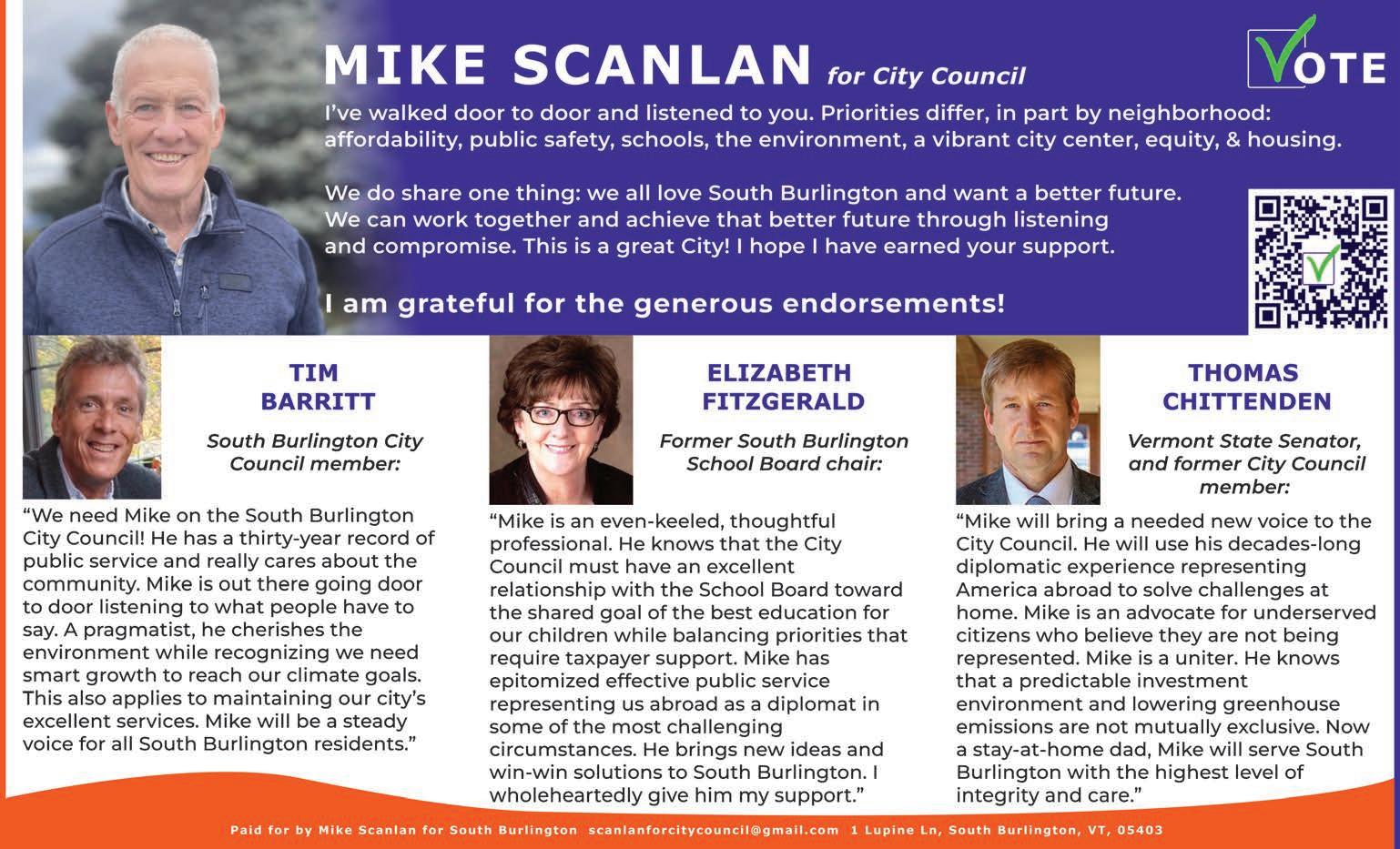

continued from page 7
and go. I have watched South Burlington’s beautiful trees and pastures turn into paved commercial lots and neighborhoods grow where trees once grew.
Unfettered development for years has caused all kinds of environmental damage, including the impairment of every South Burlington brook and stream as well as toxic traffic pollution for us to breathe.
So, when I endorse a candidate, I take into consideration what, if anything they’ll do to help South Burlington or harm South Burlington. Why are they running? Were they encouraged to run by the development community? What do they know about our city and its history?




I’m delighted to endorse Julian Keenan for the two-year seat on city council. Why? Because he is so well qualified for the position. He is a young father whose concern for future generations on this planet drives his well-informed, honest and committed positions.
His career in finance and technology will give us a councilor who can provide us with fiscal responsibility and state of the art technology.
His current service on the city’s natural resources committee informs his passion to learn and make good decisions for now and for our future concerning the environment.
His stated commitment to preserving open spaces is the winning point for me. We cannot sell out our open spaces. Without a livable planet, what else matters?


We need his young, vibrant, voice of the future on city council. Please join me in voting for Julian Keenan for the two-year seat. We need him!
South Burlington
To the Editor:
I haven’t been this excited and inspired by a candidate for city council in many, many years. The more I learn about Julian Keenan, the more convinced I am that he would make a powerful and positive impact in our city. His work and life experiences are broad and varied, giving him knowledge into the economic and technical worlds, and insight into the nonprofit world and the complex world of politics.
What I find most hopeful about Keenan is his attitude toward world of nature. He cherishes the natural world for its intrinsic beauty. He understands that
preserving nature is essential to our survival and to efforts to mitigate the impacts of the climate crisis.
Of course, we need to reduce our use of fossil fuels. We do that primarily by reducing consumption. Keenan understands that. But he also knows that it is essential that we stop destroying and damaging our natural resources.
Soon after moving here, he volunteered for the city’s natural resources and conservation committee. That’s where I got to watch and listen to him, and I came away impressed and grateful that someone like him was devoting his time to the well-being of South Burlington.
Keenan is a young man with a young family, just the demographic that South Burlington’s leaders keep saying we want to attract. It’s been a long time since we’ve had a young person on the council. We need his inspiration, his energy, his views and his voice.
Please vote for Julian Keenan on or before March 5.
Rosanne Greco
South Burlington
Vote for Smith: He ‘walks the talk’
To the Editor: I’m writing a letter of support for Laurie Smith, candidate for South Burlington City Council. As a former business owner, Smith is knowledgeable about the needs and challenges of the business community. He has a proven record of fiscal responsibility and the ability to work with others. He has walked the talk.
Smith is a contributor to his neighborhood and the city. He’s actively engaged in community events and has served on municipal committees. I support him because of his commitment to the city, breadth of experiences that have given him a strong knowledge base and a proven ability to collaborate with others.
Laurie Smith has my vote.
Donna Hale
South Burlington
Get educated, vote for this trio of candidates
To the Editor:
We are writing to encourage you to consider voting for Mike Scanlan, Linda Bailey and Elizabeth Fitzgerald for South Burlington City Council.
These three South Burlington residents bring a diverse and knowledgeable perspective to guide South Burlington into these challenging times.
We would encourage you to
explore more about Bailey and Scanlan on their pages online.
You may also read about each of these candidates’ interviews in The Other Paper online at otherpapersbvt.com. Bailey’s appeared Feb. 8, Scanlan on Jan. 25, and Fitzgerald on Dec. 14.
Make your opinion known in a meaningful way, cast your vote on Tuesday, March 5, or use the convenient early voting options.
Thank you for participating in this most important foundation of our democratic society.
Peter and Marta Taylor
South Burlington
To the Editor:
How fortunate are we that Mike Scanlan brought his family back to South Burlington. How fortunate is our community that Scanlan would like to continue his long career in service to our country by asking for us to vote for him for South Burlington City Council.
He will not be someone to predictably take sides. He will listen and look for the greater good for all residents, both fiscally and environmentally.
Scanlan’s background and vision is for multiple neighborhoods, but one community; listening to all voices; and finding common good with cooperation, listening and reaching compromise.
Scanlan is intelligent, thoughtful and absolutely the person I want to serve on city council. Please join me and vote for Mike Scanlan, an exceptional human who will do an exceptional job.
Pam Mackenzie
South Burlington
To the Editor:
The world has become even more complex after we emerged from COVID-19. As a retired person, I feel heavy hearted for our future generations. We need leaders who are passionate about public service, have a broad vision to drive a society for a better future and the skills to get work done.
I do not personally know Julian Keenan but heard good things about him. I studied the interview he gave The Other Paper (“Former U.S. diplomat seeks seat on South Burlington City Council,” Feb. 22, 2024) and watched
LETTERS
continued from page 8
the candidate forum organized for town meeting (bit.ly/3uLtz0K).
These two sources informed me the depth and breadth of Keenan’s vision and ability beyond what is on his website. The article in The Other Paper was very revealing. I urge all South Burlington voters to look at these sources before the election.
I am most impressed by his humility toward community building. I think on top of all challenges, community building, including the way we live with nature, determines the success or failure of our policy making.
Hayley Shen
South Burlington
Scanlan, Bailey offer refreshing alternative
To the Editor:
I am writing to express my enthusiastic support for Michael Scanlan and Linda Bailey as candidates for city council. In a political landscape often marred by rhetoric and misinformation, Scanlan and Bailey stand out as dedicated individuals committed to listening, researching and making educated decisions for the community.
One of the most commendable qualities of Scanlan and Bailey is their commitment to basing their decisions on facts rather than succumbing to false narratives. For instance, they recognize the importance of thoroughly examining issues such as the

impact of past development on schools and taxes.
Contrary to popular misconceptions, the data reveals that our school population has remained relatively stable and is actually less than it was 20 years ago, even with the introduction of pre-K programs. Additionally, our municipal tax rates remain low in the region, dispelling the notion of excessive tax burdens caused by development.
What sets Scanlan and Bailey apart is their dedication to taking a balanced and independent approach to governance. They understand the importance of sensible growth while also recognizing the urgency of addressing pressing issues like climate change. Furthermore, they prioritize the diverse needs of the community, ranging from infrastructure improvements to social initiatives.
In a time where the political landscape can be divisive and polarizing, Scanlan and Bailey offer a refreshing alternative. Their commitment to evidence-based decision-making and their willingness to engage with constituents make them the ideal candidates to represent our community’s interests on the city council.
I urge you to join me in supporting Michael Scanlan and Linda Bailey for South Burlington City Council. Together, they will work tirelessly to ensure a prosperous and inclusive future for our city.
Michael Keller
South Burlington
To the Editor:
I am writing to encourage you to vote for Laurie Smith for South Burlington City Council.
As a physician in practice in Chittenden County for the past 40 years, I have worked with and supervised many people, including administrators of Vermont and New England mental health programs, consulted for many area agencies, taught at The University of Vermont and led national research in prevention of depression in families.
But when I was elected to the chairman of the governing body of South Burlington Fire District #1, I knew I needed help to effectively lead this municipal entity. In South Burlington, I had long been impressed with not only Smith’s depth of knowledge and experience of municipal organization and function, but also his respectful and authoritative ability to succinctly pinpoint the exact issues of conflict, as well his deep commitment to helping his community find the best resolution in complex situations — rather than just his preference.
Smith generously agreed to act as a regular consultant to me and, for years, he helped me lead our community successfully through decisions and conflicts including legal and development issues, and the myriad of opposing, strongly felt opinions

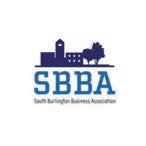
that arise in a community.
The other reason that I believe Smith warrants our support is that he has extensive experience as a builder and in development and a deep concern and commitment to preserving the environment. This is the type of person and experience that I believe is critical to lead us now.
Knowing Smith well, I know that we can trust him to help South Burlington move forward and forge a truly responsible and sustainable future.
Gary Keller South Burlington
Smith’s experience as builder will serve us well
To the Editor:
We are pleased to support Laurie Smith in his candidacy for the South Burlington City Council. Smith is a gentle and patient listener who will be receptive to the concerns of South Burlington citizens.
He has proven his commitment to the community through his service on the city planning commission. This service has enriched his knowledge and understanding of the complex issues our councilors must address.
Smith is committed to protecting our natural environment and to preserving and
See LETTERS on page 10

continued from page 9
enhancing the quality of our neighborhoods. His experience as a builder of homes will inform his ability to help South Burlington develop more affordable housing to meet the needs of citizens.
He is a team player who will work constructively with the other council members to address the many issues that come before the council. Please join us in supporting Laurie Smith for city council when you vote on March 5.
Glenn and Marga Sproul
South Burlington
Scanlan will work tirelessly on affordable housing
To the Editor:
I am writing to express my strong support for Mike Scanlan’s candidacy for South Burlington City Council.
His dedication to increasing affordable housing opportunities is commendable and necessary for ensuring that all residents have access to safe and affordable homes. With his pragmatic approach and commitment to inclusive solutions, Scanlan will work tirelessly to address the housing challenges facing our community.
Roland Groeneveld
South Burlington
To the Editor:
Vermont is facing an epidemic: a lack of affordable housing.
Families in this state, particularly low-income families and families of color, are struggling to make ends meet and are often living in substandard housing conditions.
This has led to a rise in houselessness, cost-burdens on families and out-migration from the state. All these things threaten the future of the state’s economy and well-being.
According to the Vermont Treasurer Mike Pieciak, the No. 1 reason that people are leaving the state is due to housing.
Our state has a lack of housing options available for young people who want to start their families and careers in the state. Habitat for Humanity estimates that there is currently a lack of over 7,500 units on the housing market for prospective buyers and renters.
For those looking to buy a home, the cost burden is often too high, and lower-income individuals are priced out. Without a stable, decent home, these families are missing out on opportunities to build wealth and contribute to the state’s economy.
Research has shown a correlation between homeownership and increased

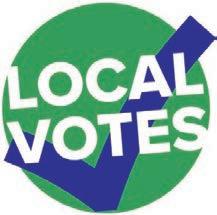
wealth, with each year of homeownership tending to be associated with an additional $9,500 in net wealth, on average, according to Habitat for Humanity.
Children of homeowners tend to transition to homeownership earlier, lengthening the period over which they can accumulate wealth, and they have homeownership rates 25 percentage points higher than the rate of children of renters.
In recent months we have seen steps toward much-needed change in this state, such as the passage of the HOME Act last year. These laws make it easier for develop-
ers and nonprofit developers to build more housing with higher densities.
But we must do more. We need to make progress, so our state can be a place where its residents can afford a safe, decent place to live.
This election season, vote with affordable housing in mind.
Ted Johnson
Shelburne
Johnson serves on the board of directors of Green Mountain Habitat for Humanity and was its past president.
Children truly are our future, and it is our duty to invest in them and support their health and well-being. I felt strongly about meeting the needs of children before, but it hits closer to home now that I am the mother of a 10-month-old who lights up our lives. That is why three of my biggest priorities this session are affordable housing, baby bonds and a Vermont Kids Code.
As chair of the Senate Committee on Economic Development, Housing & General Affairs, I am proud we recently passed a robust affordable housing bill, S.311, with a unanimous vote. It promotes multifamily housing and first-generation homeownership through changes to Act 250, municipal zoning and critical state investments.
It now has several more stops in the Legislature to balance housing and conservation interests, but I am also proud to have the support of Gov. Phil Scott for this tri-partisan legislation. We also must remember that reducing the property tax burden while maintaining quality education is best achieved by growing the grand list, and that means housing all Vermonters.
It has been a privilege to work with Vermont state treasurer Mike Pieciak on a financial tool that has real potential to close the wealth gap in this state and country. We have been working with national scholars

and leaders who have crafted the social policy of baby bonds, which would invest $10,000 in all children born into Medicaid-eligible families. The money is deposited into an interest-bearing account that young people can access to pay for housing, education, training or a business to give them the best possible opportunity to build wealth early in life.
Finally, I am proud to be the lead sponsor on the Vermont Kids Code, as part of a national, bipartisan movement to regulate online platforms so that they protect children’s privacy and well-being. As a new mom, I expect everything from my daughter’s car seat to crib to learning materials to be making her healthier and safer, not harming her.
We currently cannot expect the same of social media platforms, even though they are far more regulated in the United Kingdom and European Union. This would give our kids the same digital protections here in Vermont.
As always, please reach out with any questions or concerns. It is a privilege to serve you.
Kesha Ram Hinsdale, a Democrat from Shelburne, serves the towns of South Burlington, Shelburne, Charlotte, Hinesburg, Milton, Burlington, St. George, Westford, Underhill, Jericho, Richmond, Winooski, Williston, Essex and Bolton in the Legislature.






In February 1997, Vermont’s Supreme Court found “the current system for funding public education in Vermont, with its substantial dependence on local property taxes and resultant wide disparities in revenues available to local school districts” is in violation of the Vermont Constitution.
In response, the Vermont Legislature and governor enacted the Equal Educational Opportunity Act — Act 60 — a Vermont law intended to achieve a fair balance of educational spending across school districts independent of the degree of prosperity within each district. Act 60 was followed by Acts 68 and 130, which addressed some imbalances caused by Act 60.
Acts 68 and 130, established a system to pool the state’s educational budgetary requirements from across jurisdictions and pay for them, in part, with pooled statewide property taxes.
flat at 10,389 in 2000 and 10,618 in 2023.
Further, the National Education Association Rankings of States profiles Vermont as having the lowest ratio of enrolled students per teacher at 10.2 as compared to the national average of 15.3. Further, the Education Data Initiative profiles Vermont as spending the second highest amount per pupil on K-12 education at $24,666. The national average is $19,380.
Regarding taxpayer burdens, the Legislature’s “FY 2000 Fiscal Facts” profiles the education fund as providing $420.2 million in revenues toward K-12 education appropriations. For current fiscal year 2023, the Legislature’s Joint Fiscal Office reports that amount has increased to $1.92 billion.
As noted above, Vermonters already spend generously on their public education system. A 20 percent increase is unreasonable and intolerable.
Yet, despite these structural changes (or maybe because of them), school budgets for the coming fiscal year are in chaos.
VTDigger reports that “state economists, using the latest available school budget projections, have predicted that education spending could increase almost 15 percent next year. As a result, the latest modeling indicates the average Vermonter could expect education property tax bills to increase 20 percent. School officials say a variety of factors have compounded soaring budgets this year, from disappearing federal dollars, increasing health care costs, school construction needs, teacher salaries, special education costs and more.”
It does appear that since the passage of Act 60 that school boards and legislators have allowed themselves to become overwhelmed by the amount of school budgets and the school budget approval process.
The National Center for Education Statistics reports that Vermont’s enrollment in public elementary and secondary schools has dropped by 18,395 students, or 18 percent, from 102,049 in 2000 to 83,654 in 2022.
Yet, despite the above significant drop in school enrollments, the actuarial analyses of the Vermont State Teachers’ Retirement System for fiscal 2000 and 2023 indicate the number of active teachers in Vermont’s schools has remained essentially
The passage of Act 60 and its amendments has been embraced by most Vermonters. Equitable access to educational resources across all Vermont communities is both the law and the right public policy. However, one casualty of these reforms has been the erosion of the long-standing connection enjoyed by Vermonters relative to the passage of local school budgets.
In today’s world of equalized pupils, income sensitivity, pupil weights relative to economic and language differences, 5 percent spending caps, among many other mandates established by the Legislature, it’s hard if not impossible for most everyday Vermonters to understand the budget they are being asked to support. Given the strong influence of special interest advocates, school budgets have been substantially hijacked over the years and are now indecipherable and unaffordable for most Vermonters.
As noted above, Vermonters already spend generously on their public education system. A 20 percent increase is unreasonable and intolerable. Given the amount Vermonters already spend on education, sending budgets back to school boards and the Legislature to craft and enact fiscal reforms is the responsible course.
It’s OK for Vermonters to vote no on school budgets and deliver the message that the current entangled and costly system is not OK.
Tom Pelham of Berlin was finance commissioner in the Dean administration, tax commissioner in the Douglas administration and served on the House Committee on Appropriations as an Independent.

Gomer & Gunther
We understand the love you have for your pets and the importance they hold in your life. Our compassionate staff is devoted to easing the difficulties at this challenging time.
Our staff is here for you 24/7 Tiger & Buster
• The Island Memorial Difference:
• Pet Funerals • Cremation Services
• Your Pet is Always in Our Care
• Dignified Pet Transportation from Your Home or Vet
• Immediate & Witness Cremation Available
• Full Line of Pet Loss Products
1176 Main St. • Fairfax, VT

802-316-2284

A tribute to torpedoman Henry Breault is planned for March 15 at 9:30 a.m. to honor the 100th anniversary of his receiving the Medal of Honor.
Rep. Michael Morgan, R-Milton, is initiating a legislative resolution to honor Breault, the first submariner and only enlisted submariner to receive the Medal of Honor.
The event will take place in the House Chamber at the Statehouse.
March 15 was chosen as the Legislature will be in recess March 8, the actual date in 1924 when the Medal of Honor was presented to Breault by President Calvin Coolidge.
All veterans are encouraged to attend the resolution reading. A group of active-duty submariners from the Naval Submarine Base in Groton, Conn., and Vermont Green Mountain Base members of the U.S. Submarine Veterans plan to attend.
For more information, contact C. William Mattoon, commander, Green Mountain Submarine Veterans, Inc., at cmattoon@ vermontel.net.
Rice Memorial High School students will perform three shows of the musical, “Into the Woods,” on March 15-17 at Christ the King School in Burlington. “Into the Woods” is an

epic fairytale about wishes, family and the choices we make. The story follows a baker and his wife who want to have a child but are thwarted by a witch’s curse. The two set off on a journey to reverse the curse and bump into fairytale legends, Cinderella and Jack. It’s a dynamic performance with singing, dancing and storytelling with over 35 students involved in the show. Friday and Saturday shows are at 7 p.m., Sunday’s show is at 2 p.m. Tickets are $15 for adults, $10 for seniors, $5 for students, and children under 11 get in free.
The League of Women Voters of Vermont, in partnership with Kellogg-Hubbard Library, pres-



The Evans/Asbell Duo will present a free program of jazz from the 1940s and 1950s on Saturday, March 23, noon-1 p.m., in the auditorium. Doors open at 11:45 a.m. Their playlist will include tunes featured in this year’s Vermont Reads’ title, “Last Night at the Telegraph Club” by Malinda Lo. During her career as a performer and recording artist, Samirah Evans has become known for her dynamic and soulful approach to music, especially jazz and blues. Her musical style is heavily influenced by the New Orleans sound, where she was one of the city’s most popular and in-demand singers for nearly 20 years. The New Orleans Times Picayune named Evans’ debut CD, “Give Me a Moment,” the fifth best new release of 2002. She has also appeared as a featured or supporting vocalist on other artist’s recordings in New Orleans and New England. Evans dedicates time to perpetuating American Jazz and blues music. From his early years playing blues on Chicago’s South Side, to his present multi-faceted career based out of northern Vermont, Paul Asbell’s professional career spans 50 years. In 1978, seeking an outlet for more personal musical visions, he formed Kilimanjaro, and recorded two award-winning albums. In 1981, Paul Asbell and other members of Kilimanjaro joined forces with a legendary saxophonist and blues singer to form Big Joe Burrell and the Unknown Blues Band. The concert is free and not tickets are required. Left, Paul Asbell, right, Samirah Evans.
ents the last in its series on elections and democracy, on Wednesday, March 13, at 7 p.m., in-person at the library, 135 Main St., Montpelier.
This season looks at both structural and cultural issues that affect voter attitudes and election results with journalist Dave
Gram and M.E. Kabay, emeritus professor of computer information systems at Norwich University. They will discuss the issues of misinformation and disinformation and its potential impact on political campaigns.
Sky Barsch, CEO of VTDigger, will moderate the discussion.


The Zeta Pi community sorority, Vermont Chapter, is hosting an Egg My Yard fundraiser to benefit
See COMMUNITY NOTES on page 14


180 Market St., South Burlington 802-846-4140, southburlington library.org for information about any programming, cancellations or in-person changes. Some events may change from in-person to virtual. Some events require preregistration.
Hours: Monday to Thursday, 9 a.m.-7 p.m.; Friday, 9 a.m.-5 p.m.; and Saturday 9 a.m.-3 p.m. Email sbplinfo@southburlingtonvt.gov.
Toddlertime
Tuesdays in March, 10:30-11 a.m.
Weekly storytime for toddlers and their caregivers.
Music & movement
Thursday, March 7, 10:30-11:15 a.m.
Join Miss Emma as she leads singing, movement and jam sessions for kids from birth to age 5.
Kids’ book club for K-2
Thursdays, March 7 and 21, 4-5 p.m.
A book club for young readers and their parents. Read, share and explore the book of the month. Preregistration is required.
Lego builders
Fridays, March 8, 15, 22 and 29, 3-4:30 p.m.
Projects geared to kids ages eight and up, or ages six and up with an adult helper. Each week, builders explore, create and participate in challenges.
Storybook craftytown
Tuesday, March 12, 3-4:30 p.m.
Read a favorite story, then make a craft. Projects are geared to kids ages 8 and up, or ages 6 and up with an adult helper.
Middle school makers: cooking
Wednesdays, March 14 and 28, 4-5:30 p.m.
For students in grades five to eight. March 14: maple bacon popovers. March 28: creamy spinach parmesan orzo.
Kids’ Friday movie
Friday, March 15, 3-4:30 p.m.
“Cars” is set in a world populated entirely by anthropomorphic vehicles.
Moveable arts: Read, play, make!
Saturday, March 16, 9:15 a.m.-1:30 p.m.
With instruction by a professional arts educator Jude Bond, the
library offers a hands-on workshop for adult professionals to inspire and guide them in developing art and literature-connected projects for children ages 4 to 8 years of age. Registration limited to 20. Email nliuzzi@southburlingtonvt. gov to register.
Free play art
Tuesday, March 19, 3-4:30 p.m.
From painting to print-making and from collage to sculpture, explore different projects and mediums. Projects are geared to kids ages 8 and up, or ages 6 and up with an adult helper. March 19: swipe art painting.
Read to the therapy dog
Wednesday, March 20, 3:30-4:30 p.m.
Read to Emma the therapy dog. Sign up for 10-minute slots.
Babytime
Wednesdays, March 20 and 27, 9:30-10:15 a.m.
For infants to 12 months and their caregivers. Board books, manipulatives and baby-appropriate toys will be available for exploration and play.
Craftytown
Tuesday, March 26, 3-4:30 p.m.
Arts and craft fun. March 26: Sew a bird.
Thursdays in March, noon-3 p.m.
Yarn, needles and crochet hooks supplied. Knit or crochet hats and scarves to help keep your neighbors warm. All finished projects will be donated to the South Burlington Food Shelf.
Chess club
Saturdays in March, 11 a.m.-2:45 p.m.
The Chittenden County Chess Club hosts games in the Community Room. Pawn pushers strategize to better their games. New members always welcome. Children under 12 must be supervised by an adult.
Thursday, March 7, 2-5 p.m.
Knit crochet hats and scarves to donate to your neighbors.
Mondays, March 11 and 25, noon-1 p.m.
English as a Second Language discussion group, facilitated by staff.
Tuesdays, March 12 and 26, 11 a.m.-noon
Come share your poetry in a supportive, comfortable setting. Second and fourth Tuesday of the month.
Thursday, March 14, 10:30-11:30 a.m.
This month’s selection is “Last Night at the Telegraph Club” by Malinda Lo, set in San Francisco’s Chinatown during the 1950s. Lo was the winner of the National Book Award and the Asian/Pacific American Award for Literature. In-person and Zoom. Call 802-846-4140 for information.
Tech help
Friday, March 15, 10 a.m.-1 p.m.
Tuesday, March 19, 1-4 p.m.
Have questions about your smartphone, laptop or iPad? Sign up for a free 40-minute appointment to get some one-on-one help and learn new skills.
Saturday, March 16, 10-11:30 a.m.
Join Dr. Jolivette Anderson-Douoning as she shares her poem titled “Five Black Birds in an Ivorian Sky” and stories about her family’s trip to the West African Ivory Coast cities of Abidjan, Gagnoa, Daloa, and Paris, France. This 60-minute open studio will focus on the migration of recent immigrants to the U.S., building family within the U.S., and Black American and African immigrants’ stories, and raising children who are bi-cultural, but is designed to be inclusive and welcoming to other relationships and experiences. No registration is needed.
Mandarin conversation circle
Monday, March 19, 11 a.m.-noon
Learn and improve your Mandarin and make new friends with volunteers from Vermont Chinese School. Drop-in. No registration.
Puzzle swap
Wednesday, March 20, 2:30-5 p.m.
Bring a puzzle you’ve already completed and leave with a new puzzle to put together. Bring any 250-plus-piece general adult puzzle(s) that you would like to trade during the event. No puzzle to swap? Your first one’s on the library.
Book discussion:
‘Ministry for the Future’
Thursday, March 21, 6:30-8 p.m.
Ezra Klein of Vox says, “if I could get policymakers, and citizens, everywhere to read just one book this year, it would be Kim Stanley Robinson’s ‘The Ministry for the Future.’” Book at the library; in-person and on Zoom.
Friends of the Library free concert series
Saturday, March 23, noon-1 p.m.
The Evans / Asbell Duo pres-





continued from page 12
The University of Vermont Children’s Hospital.
Order candy-filled eggs to be delivered to your front yard the night before Easter. The cost for 12 eggs is $15; 24 eggs, $25; 48 eggs, $40; and 96 eggs, $50.
Orders are due Monday, March 18.
To order, email Amanda Zetapi at amanda.zetapi@gmail.com.
Burlington Civic Symphony holds spring concert
The Burlington Civic Symphony presents its spring concert on Saturday, March 9, at 7 p.m., in the Elley-Long Music Center in Colchester.
The program features Aaron Copland’s “Fanfare for the Common Man,” Igor Stravinsky’s “Firebird Suite” and Felix Mendelssohn’s Symphony No. 5 (“The Reformation”).
The orchestra’s music director, Daniel Bruce, conducts.
For information and tickets, go to bcsovt.org.
Tickets are $20 for adults, $15 for seniors and $10 for children and students.
Shelburne church, Age well host March luncheon
Age Well is offering a luncheon on Wednesday, March 20, in the St Catherine of Siena Parish Hall, 72 Church St. in Shelburne.
The menu is beef burgundy with mushrooms and onions,
continued from page 13
ents a program of jazz from the 1940s and 1950s. In the auditorium. Doors open at 11:45 a.m. No tickets or registration needed.
Monday, March 25, 6-8 p.m.
Join representatives Emilie Krasnow, Martin Lalonde, Kate Nugent, Noah Hyman and Brian Minier and senators Ginny Lyons, Kesha Ram Hinsdale and Tom Chittenden to discuss what’s being debated in the Statehouse.
Evening book group
Thursday, March 28, 6-7 p.m.
The March selection is “Interpreter of Maladies” by Jhumpa Lahiri. With accomplished precision and gentle eloquence, Lahiri traces the crosscurrents set in motion when immigrants, expa-
wide egg noodles, sliced carrots, green beans, wheat dinner roll with butter, Larry’s homemade oatmeal date Craisin cookie and milk.
Check-in time is 11:30 a.m. and the meal will be served at noon. There is a $5 suggested donation.
Diners must register by March 14 to Kerry Batres, nutrition coordinator, 802-662-5283 or email kbatres@agewellvt.org. Tickets are also available at the Age Well Office, 875 Roosevelt Highway, Suite 210, Colchester.
Vermont Symphonic Winds tours the galaxy
In anticipation of the solar eclipse on April 8, the Vermont Symphonic Winds, conducted by music director Lisa Jablow, will present “Preclipse,” a complete performance of “The Planets” by English composer Gustav Holst.
The concert will take place on Wednesday, March 13, at 7 p.m., at the Elley-Long Music Center in Colchester. Vermont Symphonic Winds will be joined by Bella Voce under the direction of Dawn Willis.
Each of the seven movements in the work paints a vivid musical portrait of a planet: in concert order Mars, Venus, Mercury, Jupiter, Saturn, Uranus and Neptune. Interestingly, Earth is not represented because Holst created the work from an astrological perspective. Since the Earth
Admission at the door is$15 for adults, and $10 for seniors and children. Cash and Venmo only.
triates and their children arrive, quite literally, at a cultural divide. Copies available to borrow. Both in-person and on Zoom.
My Vermont Eyes: human spirit
Thursday, March 28, 6:30-7:30 p.m.
Dr. Jolivette Anderson-Douoning looks at the experiences of girlhood and womanhood within the context of the Louisiana to Ivory Coast migrations of her family. Participants are invited to create art to reflect their own stories of coming to Vermont. Materials provided. No registration is needed.
Blood drive
March 30, 9 a.m.-1:30 p.m. Register at redcrossblood.org.
James S. (Jim) Chittenden, 88, of South Burlington, died peacefully at home on Wednesday, Feb. 14, 2024.
Jim was born in Burlington on Feb. 15, 1935, to the late J. Safford Chittenden and Reba (Stowell) Chittenden. Besides his parents, he was predeceased by his sister, Sandra C. Tallon; and his oldest son, Alan S. Chittenden.
He graduated from Burlington High School and served four years in the U. S. Navy as a medic during the Korean War.
Jim met his beloved wife, Helen, after returning from serving our country. They married on Oct. 13, 1956, at Immanuel Episcopal Church in Bellows Falls, and they lived in Burlington, Hemet, Calif., Hagaman, N.Y., Shelburne, St. Albans and Winooski, and then spent 16 years in Lenoir, N. C., before returning to Vermont in 2019.
manufacturing companies. In their retirement, he and Helen traveled extensively in a camper throughout the U.S.
Jim is survived by his wife, Helen; son, Kent Chittenden; daughter-in-law, Michelle C. Badji; five grandchildren, Sandra Chittenden, Katherine (Andrew) Rice, Patrick (Jessica) Chittenden, Jake (Avery) Chittenden and Maya Chittenden; and nine great grandchildren, Malakai, Aniyah, Trinity, Sarah, Odin, Allyna, Aliyah, Jake and Zavian.

A private graveside service will be held in the spring. Interment will occur in the Jericho Center Cemetery, near his beloved son, Alan.
In lieu of flowers, donations may be sent to the National Hemophilia Foundation, 7 Penn Plaza, Suite 1204, New York N.Y. 10001.
His work record was impeccable, first in sales and then he owned a clothing store and was a production manager in two casting
continued from page 5
dation as well.
According to the National Center for Education Statistics, Vermont had over 102,000 students in the year 2000. We were down to 83,000 students last year and are projected to continue to lose roughly 1 percent of students per year into the future. There have been no corresponding efforts at school consolidation to right size for a smaller school-aged population, and that needs to change.
Smaller schools are far more expensive to run on a per-pupil basis, and Act 127 expands incentives to avoid necessary consolidation decisions. Those incentives need to be removed. Roughly a quarter of Vermont’s 290-or so public schools have entire grades averaging 15 students or fewer, limiting educational resources for the affected kids, and driving up costs for the system as a whole.
• Administrative efficiencies: Vermont’s population is roughly that of a mid-sized U.S. city, and we need to look to where we can drive administrative efficiencies. Our school administration costs per pupil are the highest among states, and driving more administrative functions to larger entities can help reduce this. This could mean having the state department of education take on a larger role in special education, human resources, curriculum development, transportation or any of a host of high dollar services normally managed at either the school or district level.
• Facilities investments: Ironically, despite relatively high overall education spending, we’re among the bottom among states in investing in school facilities.
Arrangements are in care of Corbin & Palmer Funeral and Cremation Service, Essex Junction. To send online condolences to his family please visit vtfuneralhomes. com.
Most states provide cost-sharing funds for school construction and renovation; Vermont does not. Statewide school construction aid could be tied to consolidation efforts, with construction aid only going to schools above a certain class-size threshold.
• Re-link local decision-making to local tax rates: A revised education formula could set a baseline per-pupil spending level; for example, the New England per pupil average, and have the education fund ensure funding to that level. If communities want to invest beyond that their tax rates would rise in direct proportion to that. One of my frustrations as a school board member was that local spending decisions were so indirectly linked to ultimate tax rates, which is a problem Act 127 has made substantially worse.
So, what do we do this year? The Legislature has indicated that education funding, and yes spending levels, is a top priority, and that additional legislation is under discussion. That unfortunately is little comfort to voters heading to the voting booths in the near term to decide on school budgets. It is clear that a major reassessment of how we fund education is in order, with a necessary focus on reducing overall system costs. We likewise need a critical focus on ensuring we’re achieving the results our kids deserve from those investments, and how we achieve a balance between education and other essential needs for the state into the future.
Matt Wormser is a member of the Shelburne Selectboard.

In a big mast year for oak trees, it seems like there’s a constant barrage of acorns thwacking roofs, parked cars, and — sometimes — unsuspecting humans. These falling nuts can seem a nuisance. But when I look closely at a little acorn with its tidy hat and imagine its future, I’m reminded of what a miraculous object it is.
The acorn is a perfectly designed container packed with potential. It holds the seed that may become a towering tree that will shelter and feed thousands of creatures throughout its lifetime, including many animals that rely on acorns for winter survival. The tree’s trunk could one day become part of a timber-frame home, or it may provide fuel for a woodstove in the 22nd century.
Oak species are divided into two groups: white oaks or black (sometimes referred to as red) oaks. In the Northeast, the white oak group includes swamp white oak, chestnut oak and bur oak. The black oak group includes Northern red oak, black oak, scarlet oak and bear oak.
provide more energy, than those of white oaks.
However, these acorns also contain a higher level of tannins, making them less palatable. Most animals favor the sweeter and more digestible white oak acorns. Gray squirrels are likely to eat white oak acorns when they find them and bury those from the black oak group, whose tannins keep them well preserved. Squirrels hoard most of the undamaged black oak acorns they find, losing about 70 percent of them in the process. Those lost acorns often germinate, helping to propagate the next generation of oak trees.
White-tailed deer are among the top acorn consumers, with acorns comprising up to 75 percent of their late fall and early winter diet. One deer may eat 300 acorns per day. In a big mast year (every two to five years), deer weigh more and are more likely to produce twin fawns. Birds such as woodpeckers, blue jays and many species of ducks also consume acorns. Ducks swallow them whole, while smaller birds peck them apart — getting the value of the acorn as well as whatever lives inside it. And acorns are a favorite food of wild turkeys.
continued from page 2
South Burlington School District could have spent anywhere from $63 to $71.5 million with the same exact effect on tax bills.
Operationally, South Burlington school district’s base budget this year was $69 million, but to maximize the spending cap, the board opted in January for an additional $2 million to be allocated in the budget for the capital reserve fund.
The $71 million budget represents a nearly 14 percent increase in spending over last year, but the base minus the additional spending represents an 11 percent increase — consistent with a 10 percent year-on-year increase the district projects due to health insurance increases, contract negotiations and other benefits.
A second question on the Town Meeting Day ballot is asking voters to move an additional $2.27 million dollars in surplus from 2022 to that same capital reserve fund.
The board had a few options
to consider at its last board meeting, like whether to nix the additional spending and allocate the surplus as revenue to offset the budget, but in a 3-2 vote, the board decided to keep spending as is, at least for now.
Board members Tim Warren and Alex McHenry voted in favor of delaying the vote and adopting a leaner spending plan, but Chelsea Tillinghast, Laura Williams and board chair Kate Bailey voted against that option.
Superintendent Nichols warned that given the news around school budgets this year, it is likely that anything the board introduces initially will get voted down especially since the timeline to share new information is limited.
But prior to the vote, residents took to the mic during public comment to voice opposition and urged members to consider a delayed vote.
“I intend to vote for the budget,” Mark Gabel, resident
and bus driver with the district, said. “But boy, I’ll tell you, this is not going to fly the way it’s written. I understand the concern for wanting to put it out there on Town Meeting Day, but I think schools that have not made any adjustments or pushed the date out are making an enormous mistake.”
Board member Williams, who is also a teacher at Essex Westford school district, pleaded with the public to rethink casting a nay vote.
“Education is the cornerstone of any solid community,” she said. “The hard work that Tim and Violet and staff and we have done, I drop this at the doorstep of our Legislature. That is not our fault and that is not the fault of our children. I’m in school every day and I can tell you it is awful, the rumors of reducation in force notices, I don’t think anyone can appreciate it, the palpable sadness, anger and fear. This job is so hard.”
Most of the acorns near my house drop from the Northern red oak (Quercus rubra), one of the most widespread oak species in the Northeast. Its nut is about one inch long, and roughly the same width, giving it a rounded shape. Its cap is thin and flat like a beret, with tight, overlapping scales. This acorn spends two growing seasons on the tree, and after falling on the ground lies dormant through the winter, germinating the following spring.
My woodlands also contain white oak (Quercus alba), whose acorn is longer than it is wide and has a thicker, more rounded cap with bumpy scales that do not overlap. The cap covers about a quarter of the nut. This acorn matures in a single season, dropping in early fall and germinating almost immediately, often within a week.
For wildlife, acorns are an essential staple. They are high in calories and fat and contain protein and minerals such as calcium, potassium and phosphorus. “They are a great nugget of energy for little rodents all the way up to black bear and deer,” Steven Roberge, a forestry specialist and professor with University of New Hampshire Extension, said. “An animal has to eat a lot of leaves or bark to get such a big nutritional punch.”
While all oaks produce acorns, not all acorns are created equal, and the acorns of each group have different characteristics as a food source. Those in the black oak group have more fat, and therefore
“Turkeys use their long toes and bills to scratch through leaf litter on the forest floor and peck acorns from the ground,” Allison Keating, turkey project leader with New Hampshire Fish and Game, said. “They can temporarily store food in their crop (a muscular pouch near the throat) before it goes into the gizzard (part of the stomach), where it is ground up for digestion. Acorns not only help turkeys survive; they help them to be in better physical condition when breeding season begins, which leads to more successful breeding productivity.”
There’s an old saying that “mighty oaks from tiny acorns grow.” However, only about one in 10,000 acorns has the optimal conditions to become a mature tree. A Northern red oak can produce 5,000 to 10,000 acorns in a season, up to 10 million over its lifetime. But weather, insects and hungry animals consume the majority of these before they can germinate. Considering the odds, I’m thankful for my mature trees, even if I’m not nuts about being hit on the head by falling acorns.
Laurie D. Morrissey is a writer who lives in Hopkinton, N.H. Illustration by Adelaide Murphy Tyrol. The Outside Story is assigned and edited by Northern Woodlands magazine and sponsored by the Wellborn Ecology Fund of the New Hampshire Charitable Foundation, nhcf.org.
continued from page 1
Much of the city’s nearly $65 million budget — roughly $35.25 million — goes toward paying for general city operations and includes maintaining the same level of municipal services, while increasing some investments in public safety initiatives. These include the reinstatement of the South Burlington Police Department’s youth services sergeant, the funding of a second ambulance and an additional highway department position, according to city manager Jessie Baker.
The remainder of the budget includes funding for the city’s water, stormwater and sewer systems, as well as special funds including the city’s tax increment financing (TIF) program, for example.
The budget also takes steps toward funding initiatives laid out in the city’s climate action plan. The city will use $742,000 of Amercican Rescue Plan Act money to fund several projects: $417,000 for climate action plan implementation, $125,000 would for the city’s parks master plan, and $200,000 would go toward a grant match for the Hinesburg Road shared use path project.
The 5.82 percent tax rate would mean the average condominium owner and average homeowner — $296,619 and $438,050, respectively — would pay $85.85 and $125.31 more in municipal taxes.
Residents will vote on whether to move forward with a proposal to increase the number of members on the city’s school board.
The proposal was recommended by the city’s charter committee, which sought ways to increase representation and participation in local government.
That committee in August formally recommended that the school board expand to at least seven members, noting that other comparably sized districts have at least nine members, if not more.
South Burlington’s school board is currently made up of five members elected at-large — three of the seats are three-year terms and two are two-year terms — but current and previous board members have said five members is not enough to shoulder the school district’s workload.
City officials are asking residents to approve a $5.75 million loan, over a 30-year term, to fund the building of a second water tower on Dorset Street to increase the city’s water storage capacity to meet demand.
The city’s east storage tank, located off Dorset Street, is currently at capacity, with 98 percent of the water stored in the tank either used daily, or allocated for specific needs, such as fire flow demand or water reserved for usage during a fire.
While the city gets its water pumped from Lake Champlain by the Champlain Water District, state regulations require that the city begin planning for expanded storage after hitting 90 percent of its capacity.
New development and future growth are expected to increase the demand for drinking water and other uses.
If approved, current water users would see an annual increase if about $38.66.
The South Burlington School Board has three uncontested seats up on Town Meeting Day with a new candidate, Elaine Cissi, vying for the two-year seat vacated by the board’s current chair, Kate Bailey.
Incumbent Chelsea Tillinghast is running for reelection to her three-year seat, while Tim Warren, who was chosen by the board following the resignation of Bryan Companion in September, is seeking reelection for the one year remaining on the term.
Residents will also be asked to vote for a $71 million budget that comes with an estimated 23 percent increase to residents’ school tax bills. (See related story, page 2).




LAUREN READ
CORRESPONDENT
South Burlington danced its way into another state title on at Vergennes Union High School.
The Wolves captured the pom state championship Feb. 17, beating out second-place Middlebury and third-place Burr and Burton.
“I am overwhelmed with gratitude for each athlete,” South Burlington coach Ali Gingras said. “It is due to their camaraderie and


teamwork that this team was able to return to the podium, yet again.”
It is the eighth year in a row that South Burlington has captured the pom state title, an impressive feat considering the team has only three seniors. The team will bring plenty of experience into next season when it looks to make it nine in a row.
“The sense of community and mutual respect that this team and program has developed over the years is what, I believe, has contrib-

uted to its continued success,” Gingras said. “It is their passion for dance that has brought us together and I am grateful for the opportunity to share this journey with them.”
With the victory — and, a fourth place in the hip hop category — South Burlington will now represent Vermont in the New England dance championships in both genres.
Mount Mansfield won the hip hop and jazz categories and will join the Wolves at the New
England championships.
The competition will be held on Saturday, March 9, at South Burlington High School.
No. 12 Mount Mansfield 57, No. 5 South Burlington 50 South Burlington could not complete a fourth quarter comeback and fell to No. 12 Mount Mansfield in an upset in the Division I boys’ basketball playdowns Tuesday.
After trailing by nine midway
through the fourth, the Wolves closed the gap to 46-44 but could not find the next. Mount Mansfield then went 7-of-8 from the free throw line to seal the win.
Simon Russell had 12 points for South Burlington, which played without top scorer Tyler Bergmans due to injury. Deng Aguek added 11 points, while Andre Bouffard chipped in 10 and Paul Comba scored nine.
The Wolves finished the season at 12-9.

LAUREN READ CORRESPONDENT
Boys’ hockey
Division I Quarterfinals
Tuesday, Feb. 27 at 4:15 p.m.
No. 8 Champlain Valley (6-12-3) at No. 1 South Burlington (18-2)
For the first time since 2013, the South Burlington boys’ hockey team enters the postseason as the No. 1 seed. The Wolves have lost only twice as they look for their first D-I state title in 11 years.
South Burlington faces Champlain Valley in the quarterfinals after earning a first-round bye to start the playoffs. The Wolves beat CVU in both regular season
continued from page 1
Planning commissioner Laurie Smith and former 2022 council candidate Linda Bailey are competing for the three-year term vacated by Riehle, while Mike Scanlan, Julian Keenan and Lydia Diamond are competing for Emery’s two-year seat.
Elizabeth Fitzgerald, meanwhile, is running unopposed for the two-year seat that was vacated by Barnes in October. Barring a write-in campaign, she will likely take over the remaining year of that term.
According to campaign disclosure reports filed with the Vermont Secretary of State, more than $12,000 has been raised by the five candidates. Lydia Diamond does not have any reports filed with the state, and Elizabeth Fitzgerald said she has “neither solicited nor accepted any contributions to date” and doesn’t plan to “for the balance of my campaign.”
Contributions to the other four candidates are as follows:
• Smith reported nearly $5,000 in contributions, including donations from Riehle ($200) and Chalnick ($103). Of that amount, $1,000 from contributions totaled less than $100.
• Scanlan reported $3,410 in contributions, including a $1,000 contribution from Roeland Groeneveld, a co-founder of OnLogic. Of that amount, $1,310 came from donations that were less than $100.
• Keenan reported $1,696.68 in contributions. Of that amount, $526.24 came from donations that totaled less than $100.
• Bailey reported $3,700 in contributions, including a $1,000 donation from Groeneveld. Of that amount, $700 came from donations that were less than $100.
Nearly all their cash has been spent on media and various advertisements — be it yard signs, or advertisements in The Other Paper.
But one advertisement, paid for by the South Burlington Business Association’s political action committee, drew immediate backlash. The association’s board of directors, he said, has endorsed Bailey, Scanlan and Fitzgerald for council.
The PAC paid for advertisements first endorsing Bailey, then also for Fitzgerald and Scanlan.
Fitzgerald said she was unaware the PAC endorsed her, and Scanlan didn’t
meetings, 3-2 and 3-1.
The Wolves’ defense will likely provide the backbone for the team in the postseason after pitching four shutouts in the final four games of the regular season and seven overall. If the defense falters, South Burlington has the firepower to outscore its opponents. The Wolves scored more than two goals in 16 of their 20 games.
If South Burlington beats CVU — the game took place after press deadline — it will advance to face the winner of No. 4 Brattleboro and No. 5 Mount Mansfield in the semifinals.
Girls’ hockey
Division 1 Quarterfinals
Wednesday, Feb. 28 at 5 p.m.
respond to a request for comment.
The PAC operates an independent expenditure-only PAC, which means it conducts its activities “entirely independent of candidates” and “does not give contributions to candidates, political committees, or political parties.” It was first formed in April 2023.
According to campaign finance disclosure forms filed this month, the PAC has more than $20,500 in funds on hand. The PAC has received $10,000 in contributions from On Logic, the computer hardware company based near Technology Park. It’s also received cash contributions from Neville Investments, Spear Meadows Inc, MSK Consulting, Geri Reilly Real Estate and from the ReArch Company, a South Burlington-based construction company.
City councilor Andrew Chalnick, who won election to the council in last year’s elections, said that the PAC’s financing “is potentially enough money to control our election and degrade our democracy.”
“What is the mission and purpose of the SBBA PAC? Is it to benefit the corporate profits of a handful of mega-donors?” he said.
The business association’s PAC has spent nearly $7,000 — mostly on advertisements like the one endorsing Bailey, but also on consulting fees for Meadow Hill, a lobbying firm run by former South Burlington city councilor Matt Cota.
Cota stepped down from the council last year.
In a statement, Cota, speaking as a member of the South Burlington Business Association, said that the organization decided to take the “provocative” step of establishing a PAC “with a broader purpose in mind: to transparently communicate the association’s objectives and mission to the public.”
“The driving force behind the PAC is the shared vision of its members — to cultivate a thriving and inclusive community in South Burlington,” he said. “Recognizing the multifaceted challenges facing the city, from workforce development to affordability, the South Burlington Business Association believes that sustainable solutions hinge on expanding the tax base, fostering economic opportunities, and bolstering
No. 5 Spaulding (8-10-1) at No. 4 South Burlington (15-4-1)
South Burlington looks to make it 3-for-3 in matchups against Spaulding this season, taking on the Crimson Tide in the D-I quarterfinals Wednesday after deadline.
If the Wolves can pull off the win, they will advance to the semifinals for the first time since 2012. (South Burlington played in Division II in 2018 and 2021.)
South Burlington has momentum. In the last nine games the team went 8-0-1 into the postseason, hopefully hitting its stride at just the right moment. One of those wins included a 4-0 victory over Spaulding.
If the Wolves win, they will take on the winner of No. 1 BFA-St. Albans and No.
8 Rutland in the semifinals. BFA handed South Burlington two of its four losses during the regular season.
Girls’ basketball
Division I Playdowns
Monday, Feb. 26 at 7 p.m.
No. 11 South Burlington (2-18) at No. 6 Essex (12-8)
The girls’ basketball team is looking for a massive upset on Monday in the D-I playdowns. The two-win team will travel to Essex to face the Hornets, who have beat them by double-digits twice in the regular season.
The winner of the matchup will advance to face No. 3 Burlington on Thursday at 7 p.m. in the quarterfinals.
housing availability.”
Bailey, in a statement, said she was “very happy to receive the endorsement of the South Burlington Business Association” but added that she had “no knowledge that ads or mailings would occur until I received them in the mail” and did not know of the “political action committee’s plans in this or other campaigns.”
She likened the criticism to an “attack campaign” started by “some of my opponent’s friends and donors.”
“I want my campaign to bring people together and empower all members of our community, so I haven’t, and I won’t engage with negative campaigning,” she said. “I see that South Burlington has a need for a balanced approach to leadership, and that our community could be better united through a more open and transparent city council.”
The entrance of a political action committee into South Burlington’s elections is not new. In 2020, the Citizens for an Affordable South Burlington, Inc., encouraged residents to vote down the school district’s proposed $209.6 million bond article for a new joint middle/high school and athletic complex, according to previous reporting in The Other Paper.
And, in 2022, the Voices of the Environment, a “grassroots group of South Burlington residents concerned about the world
H.850 continued from page 4
D-Chittenden Southeast, mulled ideas like capping spending or increasing the staffto-student ratio in schools.
Senators homed in on the complexity of Vermont’s education finance system, which some suggested required systemic reform in order to simplify.
Sen. Randy Brock, R-Franklin, advocated for bringing back a tax commission that could study Vermont’s taxes as a whole, thinking about potential changes holistically rather than piecemeal.
He called Vermont’s current tax system “convoluted” and “difficult to understand,”
that we are leaving to future generations,” formed a political action committee that spent more than $8,000 in various media and advertising expenses and endorsed candidates Emery and Tim Barritt.
Chalnick and Smith are among a group of residents counted among the organization’s supporters listed on its website.
Chalnick said that a comparison between Voices of the Environment’s political action committee and the one started by the South Burlington Business Association “would be inapt” and said the environmental organization “was mostly about the residents, and much less about money.”
“(Voices of the Environment) was funded by modest contributions from many individual residents across the city,” he said. “It was to get across a message of protecting water, air and open space. Its message and mission were clear on its website. It polled all the candidates and posted the responses.”
Cota said that through the business association’s PAC, its members “have a platform to advocate” for their ideals “openly and responsibly.”
“The goal is to spark meaningful conversations within the community, moving South Burlington toward a future that embraces growth, resilience, and prosperity for all residents, businesses and visitors,” he said.
noting that even senators struggle to explain the workings of education finance.
Like Brock, Sen. Russ Ingalls, R-Essex, the only vocal opponent to H.850, called for simplicity.
Act 127 “was really well thought out,” Ingalls said, yet the Legislature “failed so miserably” and “caused so much confusion” that it hadn’t anticipated.
“I can’t go home and tell everybody what we did, what we didn’t do,” Ingalls said, citing the opaqueness of the funding system. “I just think that we need to be better.”
Gardener’s Supply, a company that provides environmentally friendly gardening products from its headquarters in Burlington, is set to expand its facilities with a seasonal nursery and retail site at 2545 Shelburne Road — the former location of the old Sirloin Saloon.
David Marshall, the engineer with the project, presented to the town’s development review board last week plans for five buildings totaling 6,432 square feet— including a greenhouse, nursery, point of sale building, and retail space — that would be reminiscent of their classic retail facilities at their other locations in Williston and Burlington.
“The nursery would operate from early May, late April for the heart of the season through fall,” Marshall said. “They would like to stay open for Christmas tree sales and seasonal activities like that. But by the middle of December, they would be pretty much closing up shop in regard to the operations.”
Pat Pearsall, the retail operations manager for Gardener’s Supply, explained that although this location will be much small-
continued from page 2
comparable towns and cities — Burlington’s annual fee is $110, and Essex is considering a $120 fee — councilors Tim Barritt and Andrew Chalnick both noted that the ordinances can be tweaked in the future.
Barritt said the city is “starting from zero” and that there likely will be changes made to the ordinance as time goes on “because we are going to gather data and we are going to learn things.”
The city has been working to craft this ordinance since January 2023. City council chair Helen Riehle, before the ordinance passed, said that the city hopes the regulations put “the kibosh on more and more houses being bought as Airbnbs.”
Another priority for the city is to ensure proper safety compliance in the city’s growing market for rental units. By creating an inspection mechanism, Riehle said the city will “be guaranteeing that when you rent an apartment or a house, that it’s safe.”
City Councilor Meaghan Emery, in her vote to approve the ordinance, said that the law came out of a case in South Burlington “where the city really had no basis on which to act with regards to an absentee landowner, and it

The site will have 50 parking spaces, but the project will also include a pedestrian walkway from Route 7 into the site with bicycle parking provided near the main entrance.
Keeping in line with the company’s dedication to environmentally friendly resources, the small 72 square-foot point-ofsale building is made entirely out of recycled water bottles and has solar-power capability, although since business hours are set to run from 10 a.m. until 6 p.m. it’s not anticipated to use much electricity.
“It’s shaped like a container, and we did brand it with our mission statement and our logo,” said Pearsall.
er than the company’s other sites, it will still provide fan favorites like potted plants and other limited gardening supplies like soil, fertilizer, seeds and a few other natural adjacencies.
“This particular operation is not going to be a year-round operation,” Pearsall said. “Most of the business we will do will be outside so the building is going to be small, mostly for our employees. Most of the space outside is going to be potted plants on the ground or on benches. So pretty
movable.”
This property sat vacant since the Sirloin Saloon closed in 2008 until a food truck owned and operated by Morgan Brook Farm opened seasonally just last year. It’s set to return this summer.
Pearsall said Gardener’s Supply is excited to work with the food truck to create a unique experience for people looking to get food, but still having access to their open garden area.
“The intention is to have seating there with a green backdrop so
that they’re kind of having both experiences,” he said. “They’re outside the fence but they’re kind of still in the garden center. We think it’d be great to the spot.”
The plan, which is set to mimic a more complex garden roadside stand, is also a new concept for the company as they look toward expansion options different than just their traditional retail stores.
“This is also a concept for us: Does this work? Is this something we can do somewhere else?” Pearsall said.
Although there was some voiced concern around the anticipated influx of traffic, the approval was granted by the review board last week, and the team is set to open its doors in just two months.
Multiple residents, like professional landscaper Tracy Beardin, showed overwhelming support for the project, with the only complaint being that the retail facility isn’t larger.
“I think that this is going to be a huge success, especially being open on Route 7,” she said.
was a very serious situation.”
“I think that it is important for the city to have the legal basis in which to protect the residents of the city,” Emery said. “I think it’s also reasonable, given the housing shortage, that we act to protect the (housing) stock and that there not be complete houses that are turned over to yearround vacation rentals.”
Previous data revealed that South Burlington had 75 total active rentals.
“I’m not waiting for Montpelier,” Barritt said. “We’ve waited before, we could be waiting another five to 10 years, it might never happen at all.”
Throughout the process of crafting the law, the council heard from dozens of individuals with short-term rentals questioning whether the regulations were too heavy handed.
“I think that it is important for the city to have the legal basis in which to protect the residents of the city.”
— Meaghan Emery
About 60 of those were considered whole units — entire homes rented out as opposed to renting a room — and of those, about 45 were single-family homes and about 15 were units in a larger building. The number of available short-term rentals has increased by nearly 25 percent over a three-year period.
During public hearings, some residents argued unsuccessfully that the city should wait to see if the state was going to move forward with a statewide registry.
At its public hearing prior to its adoption, Julie Marks, the executive director of the Vermont Short-Term Rental Alliance, said that the ordinance “will discourage people from wanting to provide any type of housing in South Burlington,” and called the provisions “ambiguous,” “impractical” and “seemingly unjust.”
“They’re also unnecessarily onerous, arbitrary and capricious,” she said. “I’ve noticed several components of this ordinance that would put the city at high risk of legal challenges and
lawsuits should this ordinance pass and be enforced.”
She added that the ordinance will “take away good paying jobs that local residents rely on, and it will likely cost the city tens of thousands in legal expenses that your taxpayers will pay for.”
Whether or not the city is opening itself up to legal action is open to debate. Burlington’s short-term rental ordinance was challenged in court by a group of short-term rental hosts in July of last year.
“We are still allowing short term rentals and we are ensuring a level of safety, and it is, I think, laudable that the Statehouse is again coming around to this, but I’m not going to hold my breath,” Emery said.
The city’s attorney, Colin McNeil, previously noted there is ongoing litigation against these types of regulations across the country, and that there is no set precedent.
“The requirement that you reside in an area has been challenged successfully in some places and has been upheld in other places,” he said. “With passage of an ordinance of this type, with the law that is not settled, because most of these
regulations are fairly new, we risk a challenge. We can’t determine the outcome until the U.S. Supreme Court weighs in on a lot of these questions that have been raised in other jurisdictions.”
The council was not in total agreement. Councilor Larry Kupferman voted no, but said the vote was a gesture to what will be a very different council in less than a month’s time, “so that there is a mark that shows that there is some concern that needs to be addressed going forward.”
Kupferman, along Riehle and Emery, are not running for reelection. Six candidates are vying for the three open seats up for grabs on March 5.
Kupferman, in previous discussions of the ordinance, questioned whether the council should separate regulations on short-term rentals from the rental registry.
“I think it’s noteworthy that, for the most part, the public response has been on the shortterm rental side of this ordinance, where in fact, the long-term rental is what we want to get going,” he said. “It’s well worth having a more in-depth review of the short-term conditions that exist.”















In the depths of winter, sugar on snow is a yearly treat many Vermonters eagerly anticipate. But with winters warming and snow barely on the ground in some parts of the state, climate change presents a host of challenges for Vermont’s iconic maple industry.
Loss of suitable growing conditions, coupled with increasing pressure from invasive insects and plants, are creating real threats. But maple syrup has never been a predictable crop, and producers are adopting new strategies, from improved technologies to boost production to forest management practices to keep the sap flowing in our warmer, wetter future.
How is climate change affecting maple production in Vermont, Quebec and the surrounding region?
Vermont is among the fastest-warming states in the U.S., along with the rest of the Northeast. The biggest shortterm threats to maple producers include high wind events, late frost or sudden, extreme warming episodes, such as those seen in 2012 and 2021, which can end the sap run prematurely for the year.
insulator that preserves maple’s shallow, fine roots.
Sugar maple also doesn’t tolerate saturated soils, and there are indications that flooding will become more common in Vermont and the northeast as the climate warms.
Another threat comes from invasive species, which have the potential to be more disruptive in an altered climate. Invasive earthworms, for example, consume the protective organic duff layer on the forest floor. That layer, together with snow, protects roots as well as seeds in the soil. Any invasive plant that shades the forest floor can prevent the establishment of new maple seedlings.
What about the timing of the sap season?
It’s important to remember that sap is not produced uniformly over the season. A few ideal days, long slow freezing events followed by moderate temperatures in the 40s (Fahrenheit), can yield 20 percent of the entire crop for the year.
As New England winters get warmer, Vermont maple producers are innovating in the face of climate change.
Over the long term, the loss of ideal conditions for both recruitment of regeneration and growth of established crop trees, which have made Vermont the top domestic syrup producer and responsible for half of all the syrup made in the U.S., will play a significant role in determining whether sugaring remains sustainable long-term.
Are there other ways in which a warming climate affects the maple industry?
Sugar maple seeds germinate at one of the lowest temperatures compared to other species, which is considered a competitive strategy, that could become a disadvantage if other species can germinate better than cold-adapted maple in our warming climate. As our winters warm even faster than our summers, a reduced snowpack means losing an important
whole industry. Instead, smaller operations still function more similarly to how they have in the past, but risk losses if they stick to a traditional calendar date to begin tapping.
How are producers responding to climate change?
Research shows the sugaring season is starting earlier and ending earlier and the duration is getting compressed. But the season has never been predictable. In the past, with smaller maple operations using a couple hundred buckets collected by hand, producers could be more responsive to temperature. Most syrup is not made that way anymore, just like most milk is not made by milking by hand anymore.
Now, 80 percent of the crop is produced by about 20 percent of the operations, and the average size of operations is increasing. A 50,000- or 100,000-tap operation, which was virtually unheard of just 40-50 years ago, is now more common. Such operations are large enough to begin tapping trees in December or January, which is necessary given the combination of an earlier end to winter and challenges finding labor.
So, maple syrup is being made in December or January, but not due solely to warm weather in these months, and the changes occurring in large operations do not represent changes happening across the
Again, historical context plays a role. A sugarbush is often comprised solely of sugar maple trees because over the decades, it was common to remove other trees and leave the sugar maples, even if the soil or other conditions were not ideal for maple. This created stands of forest composed only of sugar maple — a monoculture. Now, those stands, which were not thriving to begin with, tend to be most at risk from altered climates, novel climate stress events, drought — all those things that we expect to be coming our way. But red maple may provide some level of mitigation. It grows in the same forests as sugar maples, but red maple is a very different species and can thrive in a wider variety of conditions. Red maple sap can be boiled into syrup, too. Maintaining both varieties together can disrupt the movement of sugar maple pests, including native pests like forest tent caterpillars, which may otherwise spread easily in a warming climate.
Another mitigation strategy involves technology, which has gotten progressively better over time. Research, done in part at University of Vermont, found that collecting sap via a combination of tubing and pumps allows the operator to continue gathering sap even in less-than-optimal temperatures while also allowing a syrup operation to take full advantage of a good sap run.
This can double the sap volume collected over the course of a season, assuming the tubing system is well-maintained, and the pumps are managed in a way to harvest sap during each run. Sugarmakers remain concerned about the threats posed by climate change, but committed to incorporating strategies and technology to manage as best they can.
Mark Isselhardt is the maple extension specialist and leads the University of Vermont Extension Maple Program. He is based out of the university’s Proctor Maple Research Center.
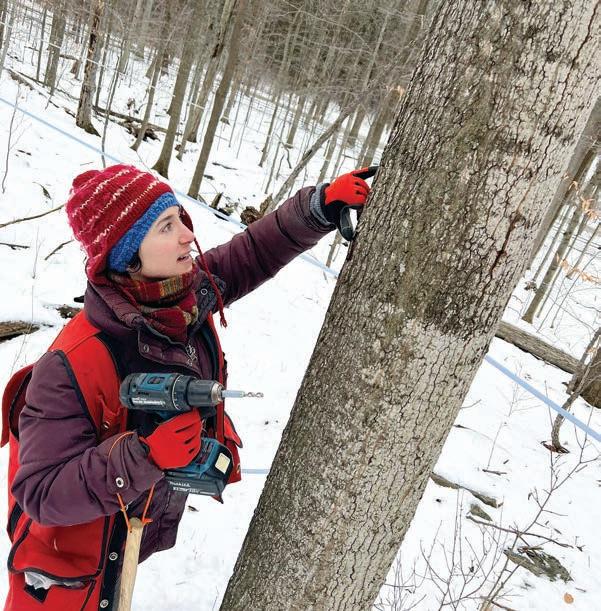
Community Bankers BUILDERS | MAKERS | DOERS®
Community Bankers
There is no better time to join our Team!
There is no better time to join our Team!
BUILDERS | MAKERS | DOERS®
There is no better time to join our Team!

There is no better time to join our Team!
BUILDERS | MAKERS | DOERS®
There is no better time to join our Team!
North eld Savings Bank, founded in 1867, is the largest LOCAL BANK in Vermont. We are committed to providing a welcoming work environment for all.
Northfield Savings Bank, founded in 1867, is the largest LOCAL BANK in Vermont. We are committed to providing a welcoming work environment for all
Northfield Savings Bank, founded in 1867, is the largest LOCAL BANK in Vermont. We are committed to providing a welcoming work environment for all
Northfield Savings Bank, founded in 1867, is the largest LOCAL BANK in Vermont. We are committed to providing a welcoming work environment for all
Consider joining our team as a Community Banker at our Taft Corners or Richmond location!
Northfield Savings Bank, founded in 1867, is the largest LOCAL BANK in Vermont. We are committed to providing a welcoming work environment for all
Consider joining our team as a Community Banker at our Taft Corners or Richmond location!
Consider joining our team as a Community Banker at our Taft Corners or Richmond location!
Relevant Skills: Customer Service, Cash Handling (we’ll train you!) Even better… if you have prior banking experience, we encourage you to apply!
Consider joining our team as a Community Banker at our Taft Corners or Richmond location!
Relevant Skills: Customer Service, Cash Handling (we’ll train you!) Even better… if you have prior banking experience, we encourage you to apply!
Relevant Skills: Customer Service, Cash Handling (we’ll train you!) Even better… if you have prior banking experience, we encourage you to apply!
Relevant Skills: Customer Service, Cash Handling (we’ll train you!)
If you are 18 or older and have a high school diploma, general education (GED) degree, or equivalent, consider joining the NSB Team!
Even better… if you have prior banking experience, we encourage you to apply!
If you are 18 or older and have a high school diploma, general education (GED) degree, or equivalent, consider joining the NSB Team!
Opportunity for Growth
If you are 18 or older and have a high school diploma, general education (GED) degree, or equivalent, consider joining the NSB Team!
Opportunity for Growth
If you are 18 or older and have a high school diploma, general education (GED) degree, or equivalent, consider joining the NSB Team!
Opportunity for Growth
NSB has training opportunities to engage employees and assist with professional development within our company.
Opportunity for Growth
NSB has training opportunities to engage employees and assist with professionaldevelopment within our company. The average years of service for an NSB employee is 9! If you’re looking for a careerin an environment that promotes growth, join our team!
What NSB Can Offer You
NSB has training opportunities to engage employees and assist with professional development within our company. The average years of service for an NSB employee is 9! If you’re looking for a career in an environment that promotes growth, join our team!
The average years of service for an NSB employee is 9! If you’re looking for a career in an environment that promotes growth, join our team!
What NSB Can Offer You
What NSB Can Offer You
NSB has training opportunities to engage employees and assist with professional development within our company. The average years of service for an NSB employee is 9! If you’re looking for a career in an environment that promotes growth, join our team!
What NSB Can Offer You
Competitive compensation based on experience. Wellrounded benefits package. Profit-Sharing opportunity. Excellent 401(k) matching retirement program. Commitment to professional development. Opportunities to volunteer and support our communities. Work -Life balance!
Competitive compensation based on experience. Wellrounded benefits package. Profit-Sharing opportunity. Excellent 401(k) matching retirement program. Commitment to professional development. Opportunities to volunteer and support our communities. Work -Life balance!
Competitive compensation based on experience. Wellrounded benefits package. Profit-Sharing opportunity. Excellent 401(k) matching retirement program. Commitment to professional development. Opportunities to volunteer and support our communities. Work -Life balance!
Competitive compensation based on experience. Wellrounded benefits package. Profit-Sharing opportunity. Excellent 401(k) matching retirement program. Commitment to professional development. Opportunities to volunteer and support our communities. Work -Life balance!
Please send an NSB Application & your resume in confidence to: Careers@nsbvt.com
Please send an NSB Application & your resume in confidence to: Careers@nsbvt.com
Please send an NSB Application & your resume in confidence to: Careers@nsbvt.com
Please send an NSB Application & your resume in confidence to: Careers@nsbvt.com


Equal Opportunity Employer / Member FDIC
Equal Opportunity Employer / Member FDIC
Equal Opportunity Employer / Member FDIC
Equal Opportunity Employer / Member
Continues commitment to service delivery
• Completes implementation of the second ambulance ($220,000)
• Adds a Highway position ($77,000)
• Increases in sidewalk maintenance ($38,000)
• Adds a part time Library position ($23,500)
• Increases funding to the Housing Trust Fund ($25,000)
• Reinstates the SBPD Youth Services Sergeant ($107,000)
• Funds school crossing guards at 50% ($30,000)
• Directs capital funds to infrastructure improvements on Dorset Street at the Middle School and High School ($100,000)
• General Fund capacity for a Climate Director and targeted consulting needs ($190,000)
• Funds Green Mountain Transit increase ($63,000)
• Allocates ARPA funding ($417,000) for:
• Electric lawn mower
• Charging stations at DPW
• Weatherization and window replacement
• Public Transit Study
• Active Transportation Projects
• More water storage
• Will provide enough water in the high service area for the foreseeable future (50+ years)
• Allows us to meet regulatory requirements
• Provides more water storage in the event of an emergency (pump/pipe failure, large water usage for firefighting, etc.)
• Can more easily complete maintenance by temporarily taking one tank offline
• The project will not increase pressure beyond what is provided today, but the second tank will provide greater operational flexibility so that the system can be operated towards the higher end of operating pressures
Assuming a $5.75M loan, over a 30-year term, at 4.40% interest:
• Our annual loan payment would be $349,000*
• In order to make this loan payment, our rates would increase by $4.82* per 1,000 cubic feet of water
• This would result in an annual increase of $38.66* for the average residential user
*These values represent a worst-case scenario and do not include project cost reductions related to grant funding